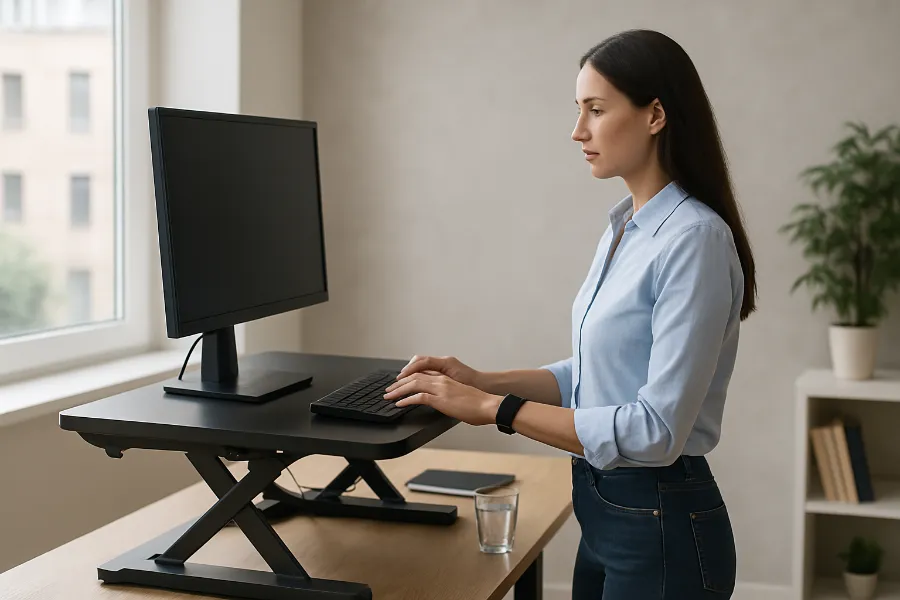
Posture influences the entire body, from how muscles work to how easily a person breathes. When posture is aligned, movements feel natural, fatigue decreases, and discomfort is minimized. Poor posture, on the other hand, places excess strain on the spine, neck, and shoulders, often leading to pain or long-term musculoskeletal issues. As daily life increasingly involves computers, digital devices, and prolonged sitting, posture awareness has become essential for physical well-being.
Ergonomics, the science of arranging environments and behaviors to support the body, helps reduce strain and improve comfort. The National Institute for Occupational Safety and Health (NIOSH), part of the U.S. Centers for Disease Control and Prevention, emphasizes ergonomics as a preventive approach that reduces injuries and improves work comfort (https://www.cdc.gov/niosh/topics/ergonomics/). Applying ergonomic principles to everyday activities supports the body’s natural alignment and reduces unnecessary stress.
This expanded guide explores posture when sitting and standing, how movement supports spinal health, and practical steps to build long-term body awareness.
Understanding Neutral Alignment
The human spine has three natural curves: the cervical curve in the neck, the thoracic curve in the upper back, and the lumbar curve in the lower back. These curves help absorb impact and distribute weight evenly. When the spine is in neutral alignment, these curves are present and balanced not exaggerated or flattened. The “Human vertebral column” article on Wikipedia offers helpful illustrations of these spinal curves.
Neutral alignment is not a stiff or forced position. It is a state where the body feels stable and relaxed. When the spine is aligned, the muscles that support it do not have to overwork, and the joints do not experience unnecessary pressure.
To feel neutral alignment:
• Imagine the head floating upward as though suspended from above.
• Let the shoulders relax, not rounding forward or pulling tightly back.
• Keep the pelvis balanced, not tipped forward or tucked under.
• Allow the ribcage to settle gently over the hips without flaring upward.
Neutral posture should feel sustainable. If it feels forced or exhausting, tension is likely present somewhere in the body.
Ergonomic Sitting Posture Tips
Sitting seems restful, yet prolonged sitting is one of the most common sources of back and neck discomfort. The key is not only how one sits but how the workstation is arranged.
1. Support the Lower Back (Lumbar Curve)
The lower back naturally curves inward. A lack of support often causes the curve to collapse, leading to slouching. A chair with built-in lumbar support is ideal. If unavailable, a rolled towel or cylindrical cushion placed behind the lower back can help.
2. Sit with the Hips Back in the Chair
Scooting to the edge of the chair can cause rounding of the lower back. Sitting with the hips fully back in the seat keeps the spine more naturally aligned.
3. Keep Feet Grounded
Feet should be flat on the floor, not dangling or tucked behind the chair. If the desk height requires the chair to be raised, use a footrest or a firm box.
4. Adjust Seat Height and Hip Position
The hips should ideally be level with or slightly higher than the knees. This allows the pelvis to remain in a neutral position rather than tipping backward.
5. Relax the Shoulders
Shoulders often lift unconsciously when typing, especially if armrests are too low or absent. Adjust armrests so elbows can bend comfortably to about 90 degrees and rest naturally.
6. Position the Screen at Eye Level
The neck is highly sensitive to forward movement. Leaning the head just one inch forward can double the load on the neck muscles. Raising the screen so the eyes meet the top third of the screen prevents unnecessary strain.
7. Keep Frequently Used Items Within Reach
Repetitive reaching strains the shoulders. Keep water, notepads, phones, and most-used tools close.
8. Shift Position Regularly
Even perfect posture becomes uncomfortable if held too long. Changing position is part of healthy sitting.
Ergonomic Standing Posture Tips
Standing can relieve pressure on the spine, but prolonged or misaligned standing can also cause fatigue. Balanced standing posture distributes weight efficiently and helps avoid strain.
1. Stand with Even Weight Distribution
Favoring one side or hip is common and often unconscious. Check occasionally that weight is shared between both legs.
2. Keep Knees Soft
Locked knees push the pelvis and spine out of alignment. Softening the knees helps engage leg muscles evenly.
3. Align Hips Over Feet
The pelvis should feel as if it is stacked over the ankles rather than pushed forward or pulled backward.
4. Keep the Ribcage Relaxed
Chest lifting too high creates tension in the lower back. Let the ribs settle while maintaining open posture.
5. Align the Head
The head should balance over the spine not tilt forward. Gently retracting the chin brings alignment without strain.
Using a Standing Desk Effectively

Standing desks can be helpful for reducing time spent sitting, but standing all day is not the goal. Too much standing can cause foot fatigue, lower back tension, and stiffness.
The most supportive approach is rotation, such as:
• Sit for 45–60 minutes
• Stand for 20–30 minutes
• Move briefly between transitions
Supportive tools for standing desks include:
• Cushioned anti-fatigue mats
• Supportive footwear
• Adjustable monitor height
Variety keeps the body energized.
Movement: The Missing Piece in Posture
Posture is dynamic. The body is designed to move. Even when alignment is good, remaining still too long causes muscles to tire.
Movement increases circulation, lubricates joints, and reduces stiffness. Small, frequent actions are more effective than occasional intense stretching.
Daily movement examples:
• Shoulder rolls every hour
• Gentle neck stretches
• Standing up to refill water
• Short walks between focused work sessions
Adding regular physical activity strengthens the muscles that support posture. Yoga, Pilates, barre, and strength training all benefit spinal support and body awareness.
Strengthening Key Muscle Groups for Better Posture
Posture relies on several major muscle groups working together—not just the back.
Core muscles stabilize the spine and pelvis.
Hip muscles support walking, standing, and sitting transitions.
Upper back muscles maintain open shoulder posture.
Strength-building does not require intense workouts. Even short, daily routines make a measurable difference.
Example simple exercises:
• Planks (even short holds)
• Wall angels
• Hip bridges
• Seated or standing rows with a resistance band
Steady, moderate strengthening contributes more to posture than occasional high-effort workouts.
Building Awareness and Sustainable Habits
Posture habits form over years and change gradually. Awareness is the foundation for improvement.
Support your posture practice by:
• Placing posture reminders where you tend to slouch
• Checking in with your breathing (restricted breath often signals tension)
• Modifying your environment to make alignment easier
The more often the body returns to alignment, the more natural it becomes.
Easing Discomfort While Adjusting Posture

When improving posture, mild soreness can occur as underused muscles awaken. This is normal. Discomfort should not be sharp or intense. Movement, stretching, and patience help adaptation.
Supportive relief strategies:
• Gentle heat to ease tension
• Stretching the chest and hip flexors
• Strengthening the upper back and deep core
• Gradual workstation adjustments
If pain persists or intensifies, consider consulting a physical therapist. They can provide personalized evaluation and exercises.
Final Thoughts
Ergonomic posture is not about forcing the body to stay rigid. It is about finding balance—supporting the spine’s natural curves, keeping the body relaxed, and allowing movement throughout the day. Awareness and small adjustments create meaningful improvements over time.
Whether sitting, standing, or transitioning between both, posture benefits most from ease, balance, and motion. With mindful alignment and regular movement, posture becomes less of a correction and more of a natural state of comfort and strength.
FAQs
Ergonomic posture means positioning your body so your spine stays in its natural alignment while muscles and joints work efficiently.
Good posture reduces muscle strain, prevents pain, and helps improve breathing and circulation.
Sit with your feet flat, lower back supported, shoulders relaxed, and screen at eye level.
Stand with weight evenly distributed, knees soft, and head aligned above the spine.
No. Alternate between sitting and standing to avoid fatigue and keep muscles active.
Stand or move briefly every 30–60 minutes to reduce stiffness and improve circulation.
Shoulders often rise unconsciously when typing; adjusting armrests and relaxing elbows can help.
Yes. Strengthening core, upper back, and hip muscles improves stability and alignment.
Occasional slouching is normal, but habitual slouching can lead to muscle imbalance and discomfort.
With consistent awareness and small adjustments, noticeable improvement often occurs within weeks.













